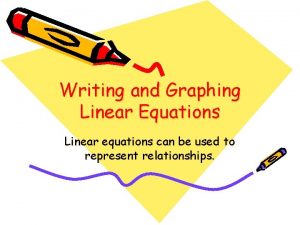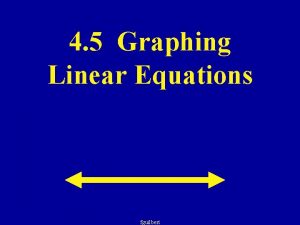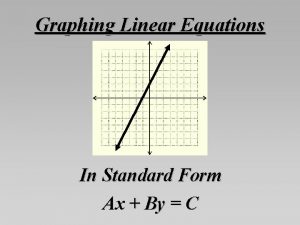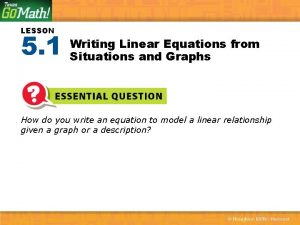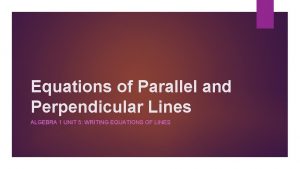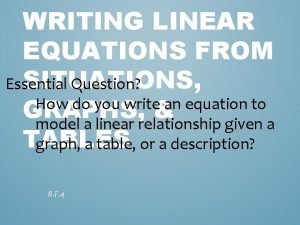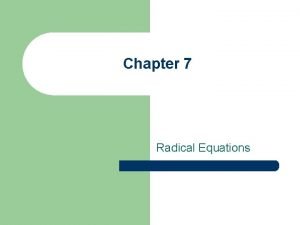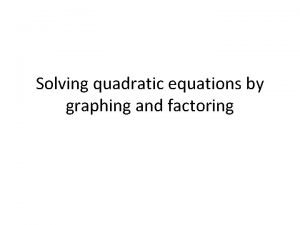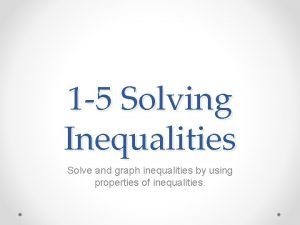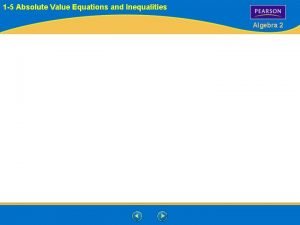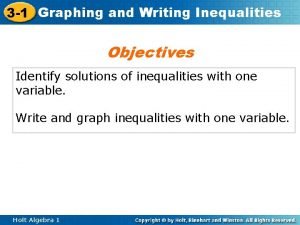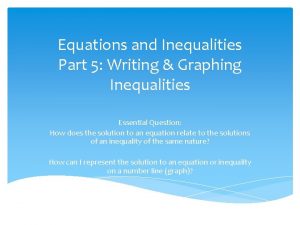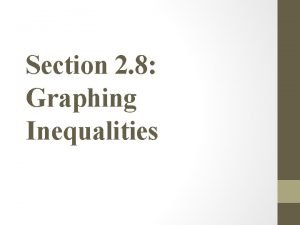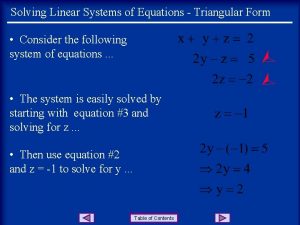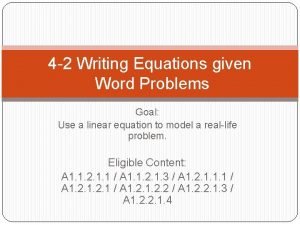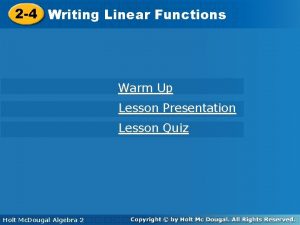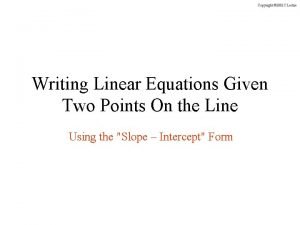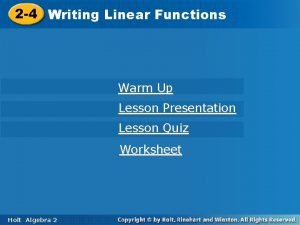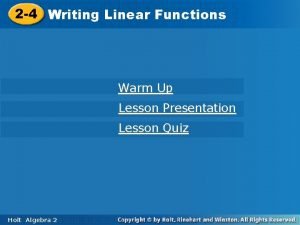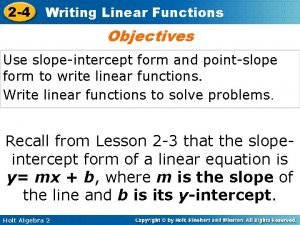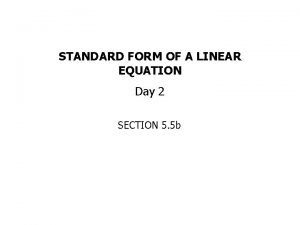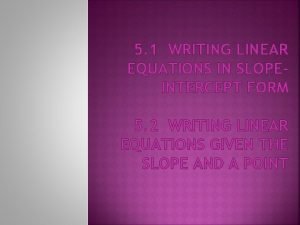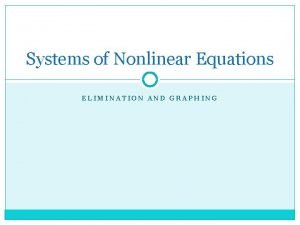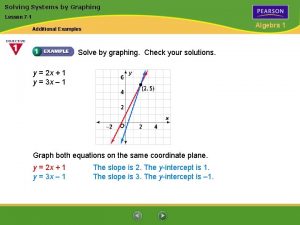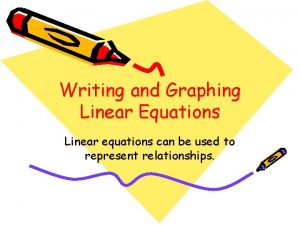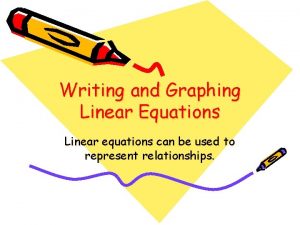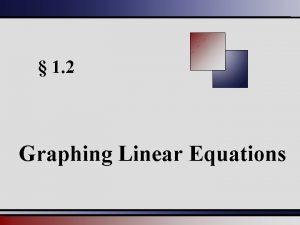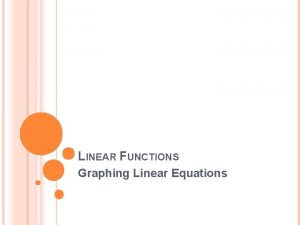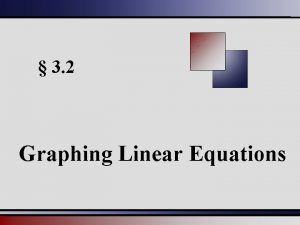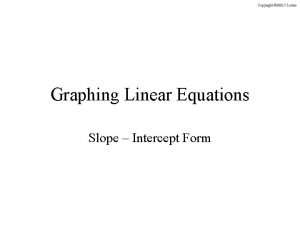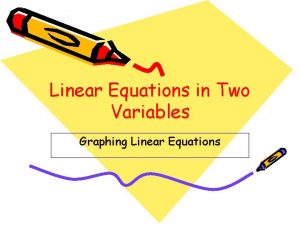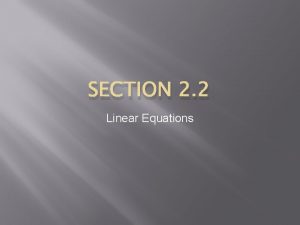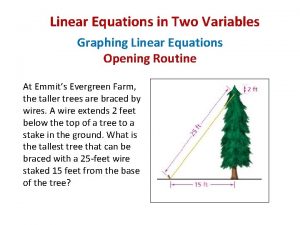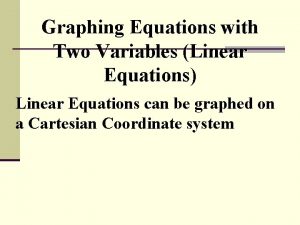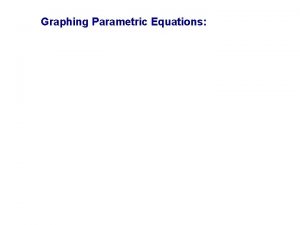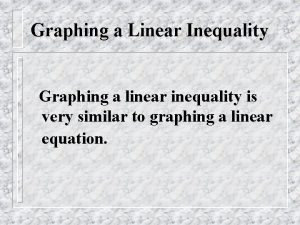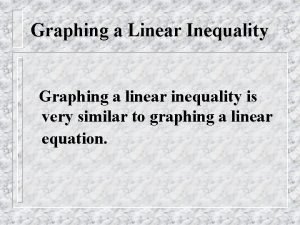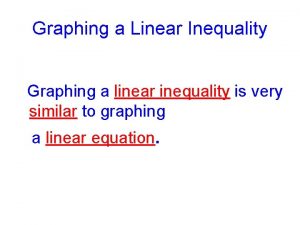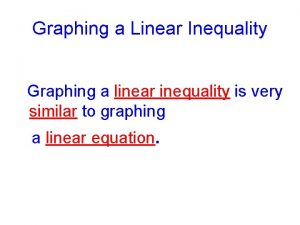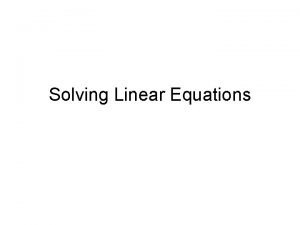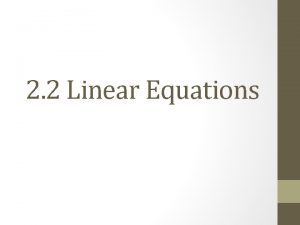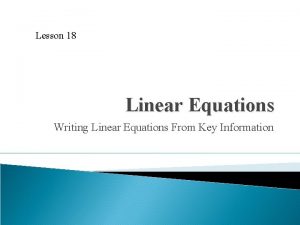Writing and Graphing Linear Equations Linear equations can



































- Slides: 35

Writing and Graphing Linear Equations Linear equations can be used to represent relationships.

Slope Rate of change

Remember, linear equations have constant slope. For a line on the coordinate plane, slope is the following ratio. This ratio is often referred to as “rise over run”.

Find the slope of the line that passes through each pair of points. 1) (1, 3) and (2, 4) 2) (0, 0) and (6, -3) 3) (2, -5) and (1, -2) 4) (3, 1) and (0, 3) 5) (-2, -8) and (1, 4)

Slopes: positive, negative, no slope (zero), undefined.

Using Slopes and Intercepts x-intercepts and y-intercepts


x-intercept – the x-coordinate of the point where the graph of a line crosses the x-axis (where y = 0). y-intercept – the y-coordinate of the point where the graph of a line crosses the y-axis (where x = 0). Slope-intercept form (of an equation) – a linear equation written in the form y = mx +b, where m represents slope and b represents the yintercept. Standard form (of an equation) – an equation written in the form of Ax + By = C, where A, B, and C are real numbers, and A and B are both ≠ 0.

• The standard form of a linear equation, you can use the x- and yintercepts to make a graph. • The x-intercept is the x-value of the point where the line crosses. • The y-intercept is the y-value of the point where the line crosses. Standard Form of an Equation Ax + By = C

To graph a linear equation in standard form, you fine the x-intercept by substituting 0 for y and solving for x. Then substitute 0 for x and solve for y. 2 x + 3 y = 6 2 x + 3(0) = 6 2 x = 6 x=3 2 x + 3 y = 6 2(0) + 3 y = 6 y=2 The x-intercept is 3. (y = 0) The y-intercept is 2. (x = 0)

Let’s take a look at that equation again! 2 x + 3 y = 6 Since 3(0) = 0, just cover up the 3 y and solve what’s left. 2 x = 6 x=3 2 x + 3 y = 6 y=2 Again, since 2(0) = 0, just cover up 2 x and solve what’s left. Since you are substituting (0) in for one variable and solving for the other, any number multiplied times (0) = 0. So, in the first example 3(0) = 0, and in the second example 2(0) = 0.

Find the x-intercept and y-intercept of each line. Use the intercepts to graph the equation. 1) x–y=5 2) 2 x + 3 y = 12 3) 4 x = 12 + 3 y 4) 2 x + y = 7 5) 2 y = 20 – 4 x

Slope-intercept Form y = mx + b

• An equation whose graph is a straight line is a linear equation. Since a function rule is an equation, a function can also be linear. • m = slope • b = y-intercept Slope-intercept Form Y = mx + b (if you know the slope and where the line crosses the y-axis, use this form)

Given the slope and y-intercept, write the equation of a line in slope-intercept form. 1) m = 3, b = -14 2) m = -½, b = 4 3) m = -3, b = -7 4) m = 1/2 , b = 0 5) m = 2, b = 4 Slope-intercept form of an equation Y = mx + b

Using slope-intercept form to write equations, Rewrite the equation solving for y = to determine the slope and y-intercept. 3 x – y = 14 -y = -3 x + 14 -1 -1 -1 y = 3 x – 14 or 3 x – y = 14 3 x = y + 14 3 x – 14 = y x + 2 y = 8 2 y = -x + 8 2 2 2 y = -1 x + 4 2

Write each equation in slope-intercept form. Identify the slope and y-intercept. 2 x + y = 10 -4 x + y = 6 4 x + 3 y = 9 2 x + y = 3 5 y = 3 x

Write the equation of a line in slope-intercept form that passes through points (3, -4) and (-1, 4). Do you remember the slope formula? 1) Find the slope. 4 – (-4) 8 -1 – 3 -4 m = -2 2) Choose either point and substitute. Solve for b. y = mx + b (3, -4) -4 = (-2)(3) + b -4 = -6 + b 2=b Substitute m and b in equation. Y = mx + b Y = -2 x + 2

Write the equation of the line in slope-intercept form that passes through each pair of points. 1) (-1, -6) and (2, 6) 2) (0, 5) and (3, 1) 3) (3, 5) and (6, 6) 4) (0, -7) and (4, 25) 5) (-1, 1) and (3, -3)

Equation Forms (review) When working with straight lines, there are often many ways to arrive at an equation or a graph.

Slope Intercept Form If you know the slope and where the line crosses the y-axis, use this form. y = mx + b m = slope b = y-intercept (where the line crosses the y-axis)


Horizontal Lines y=3 (or any number) Lines that are horizontal have a slope of zero. They have “run” but no “rise”. The rise/run formula for slope always equals zero since rise = o. y = mx + b y = 0 x + 3 y=3 This equation also describes what is happening to the y-coordinates on the line. In this case, they are always 3.

Vertical Lines x = -2 Lines that are vertical have no slope (it does not exist). They have “rise”, but no “run”. The rise/run formula for slope always has a zero denominator and is undefined. These lines are described by what is happening to their x-coordinates. In this example, the xcoordinates are always equal to -2.

There are several ways to graph a straight line given its equation. Let’s quickly refresh our memories on equations of straight lines:

Remember If a point lies on a line, its coordinates make the equation true. (2, 1) on the line y = 2 x -3 because 1 = 2(2) - 3 Before graphing a line, be sure that your equation starts with “ y =” To graph 6 x + 2 y = 8 rewrite the equation: 2 y = -6 x + 8 Y = -3 x + 4 Now graph the line using either slope intercept method or table method.

Practice with Equations of Lines Answer the following questions dealing with equations and graphs of straight lines. 1) Which of the following equations passes through the points (2, 1) and (5, -2)? a. c. y = 3/7 x + 5 y = -x + 2 b. y = -x + 3 d. y = -1/3 x + 3

2) Does the graph of the straight line with slope of 2 and y-intercept of 3 pass through the point (5, 13)? Yes No

3) The slope of this line is 3/2? True False

4) What is the slope of the line 3 x + 2 y = 12? a) b) c) d) 3 3/2 -3/2 2

5) Which is the slope of the line through (-2, 3) and (4, -5)? a) b) c) d) -4/3 -3/4 4/3 -1/3

6) What is the slope of the line shown in the chart below? a) b) c) d) 1 3/2 3 3/5

7) Does the line 2 y + x = 7 pass through the point (1, 3)? True False

8) Which is the equation of a line whose slope is undefined? a) b) c) d) x = -5 y=7 x=y x+y=0

9) Which is the equation of a line that passes through (2, 5) and has slope -3? a) b) c) d) y = -3 x – 3 y = -3 x + 17 y = -3 x + 11 y = -3 x + 5
 How to write an equation in slope intercept form
How to write an equation in slope intercept form Lesson 5 graphing linear equations and inequalities
Lesson 5 graphing linear equations and inequalities 4-5 graphing linear equations
4-5 graphing linear equations Graphing linear equations definition
Graphing linear equations definition Ax + by=c
Ax + by=c Graphing linear equations vocabulary
Graphing linear equations vocabulary 5-1 writing linear equations from situations and graphs
5-1 writing linear equations from situations and graphs Write equations of parallel and perpendicular lines
Write equations of parallel and perpendicular lines 5-1 writing linear equations from situations and graphs
5-1 writing linear equations from situations and graphs Contoh soal persamaan simultan 3 variabel
Contoh soal persamaan simultan 3 variabel Difference between linear and non linear equations
Difference between linear and non linear equations Simultaneous nonlinear equations
Simultaneous nonlinear equations Lesson 7 - graphing radical equations and inequalities
Lesson 7 - graphing radical equations and inequalities How to find roots of equation
How to find roots of equation 1-5 solving inequalities answers
1-5 solving inequalities answers Lesson 4-1 absolute value equations
Lesson 4-1 absolute value equations Writing and graphing inequalities
Writing and graphing inequalities 2-1 graphing and writing inequalities
2-1 graphing and writing inequalities Graphing and writing inequalities
Graphing and writing inequalities Writing and graphing inequalities
Writing and graphing inequalities Graphing linear-quadratic systems
Graphing linear-quadratic systems 2-8 graphing linear and absolute value inequalities
2-8 graphing linear and absolute value inequalities Graphing linear and exponential functions
Graphing linear and exponential functions Triangular form system of equations
Triangular form system of equations Unit 4 linear equations
Unit 4 linear equations Writing linear equations from word problems worksheet
Writing linear equations from word problems worksheet How to write slope-intercept form
How to write slope-intercept form Lesson 2-4 writing linear equations
Lesson 2-4 writing linear equations How to find the y intercept of two points
How to find the y intercept of two points 3-3 lesson quiz transforming linear functions answer key
3-3 lesson quiz transforming linear functions answer key 2-4 writing linear equations
2-4 writing linear equations 2-4 writing linear equations
2-4 writing linear equations Linear equations standard form
Linear equations standard form Slopeintercept form
Slopeintercept form Graphing systems of nonlinear equations
Graphing systems of nonlinear equations Lesson 7 solve systems of equations by graphing
Lesson 7 solve systems of equations by graphing
